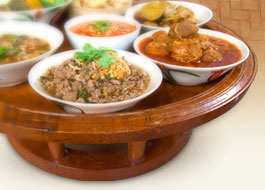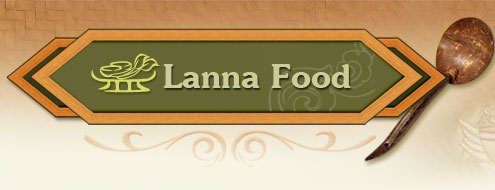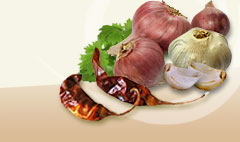Ginger |
|
|
 | Zingiber officinale |
|
| |
 | Zingiberaceae |
|
| |
 | Ginger |
|
| |
 | Khing Phueak , khing yuak, khing ban (Rattana Phromphichai, 1999, p. 694) |
|
| |
 | Perennial, underground rhizome with stem reaches a height of 1 m., made up of closely enveloping leaf sheaths. The yellow flowers are on special stalks rising from the underground stem, one flower from the axil of a flowering bract. The more pungent kind has a smaller rhizome and is called khing khraeng or kaeng (Lanna), khing pa or khao. (Wut Wuthithamwet, 1997, pp. 134-135) |
|
| |
 |

Contains protein, carbohydrates, calcium, phosphorus, iron, niacin, Vitamin C and fiber. (Phak Phuen Ban A-han Phuen Mueang, 2007, 38). Lanna people use both the rhizome and leaves in main dishes and desserts. The rhizome is used in namphrik khing, as an ingredient in kaeng hang le; leaves are put in kaeng khae, aep pla, aep ihuak to improve the aroma and flavor. Fresh leaves are eaten with yam no mai, khua no mai; rhizomes are pickled to be chewed with miang. (Rattana Phromphichai, 1999, pp. 694-695) |

Rhizomes: Spicy hot and sweet taste helps relieve stuffy or upset stomach, nausea, bring up phlegm, treats dysentery, coughs (by crushing or pulverizing it and mixing in hot water boiled for drinking or the fresh liquid can be mixed with lemon juice and a little salt for slow sipping. Caution: Too strong a concentration of ginger extract could stop intestines from contracting. Leaves: have a spicy hot taste and helps stop nasal bleeding, treats bruises, kidney stones, induces urination, treats eye diseases, expels worms from the intestines. Flower: Used to relieve nervous tension, depression, improve digestion, urine flow. Roots: Spicy hot and bittersweet, help relax upset stomach, bring up phlegm, improve appetite, treats dysentery, clears up voice. Berries: Spicy hot and sweet, help stimulate flow of milk for women who have just given birth, relieves fever, dry throat, sore throat, blurred vision and serves as a tonic for longevity. Rhizome of wild ginger (Khing khraeng) can be used to relieve fever, constipation, upset stomach, insomnia, nausea. (Wut Wuthithamwet, 1997, pp. 134-135)
Lanna Pharmaceutical Indication: Ginger is used in medicine or better blood circulation, epilepsy, dry throat, poor appetite and coughs (Chiradet and Arunya Manosoi, 1994, p. 90) |
|
| |
 | All year round |
|
| |
 |
Chiradet and Arunya Manosoi. (1994). Lanna Pharmaceutics: Lanna Herbal Medicine. Bangkok: Institute or Traditional Thai Medicine. (in Thai). Rattana Phromphichai. (1999). Khing. In Saranukrom Wattanatham Thai Phak Nuea. (Vol. 2, pp. 694-695). Bangkok: The Siam Commercial Bank Foundation for the Encyclopedia of Thai Culture. (in Thai). Wut Wuthithamwet. (1997). Saranukrom Samunphrai Thai: Ruam Lak
Pesatchakam Thai. Bangkok: Odean Store. (in Thai). |
|
| |
|
|




